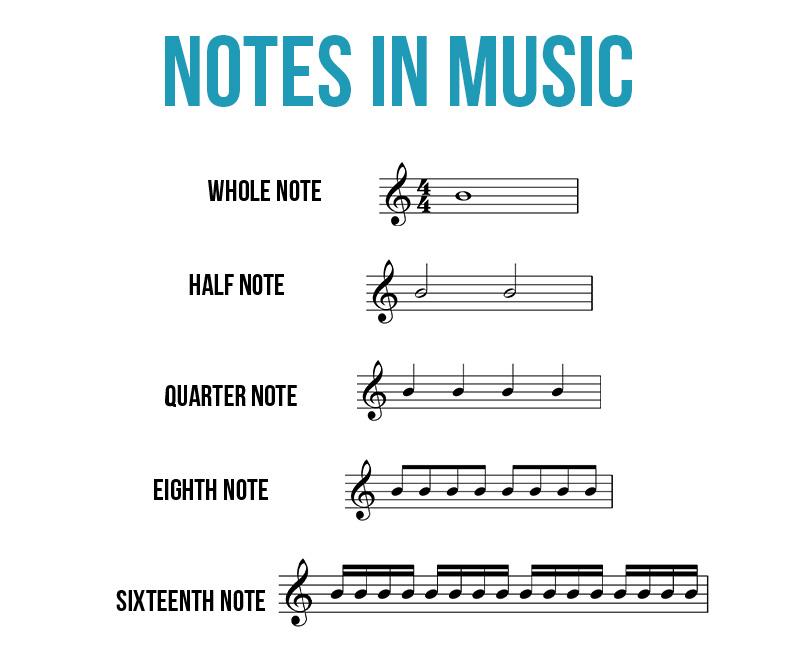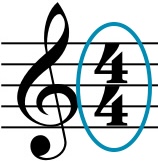Guide to Notes in Musical Notation
Learn all about the rhythm, duration, and values of notes in music in this comprehensive guide.
Music notes
Musical notes consist of two elements: pitch and rhythm. The pitch of a note depends on its position on the musical staff (as well as the key signature and whether any accidentals are present).
The rhythm of music notes, however, depends on the kind of symbol used for the note. Each symbol communicates a different duration or note value. Here’s a quick overview:
- Whole note: hollow oval notehead with no stem
- Half note: hollow circle notehead with stem
- Quarter note: solid circle notehead with stem
- Eighth note: solid circle notehead with stem and flag
- Sixteenth note: solid circle notehead with stem and two flags

Time signature
 The numbers next to the whole note, 4/4, indicate the time signature. This tells us how to measure the beat. The bottom number signifies what kind of note we use for the basic beat. And the top number tells us how many of those notes are in each measure. So, in this case, 4/4 means we have four quarter notes in each measure. The bottom “4” means quarter. (2 on the bottom means half note, and 8 on the bottom means eighth note.) All of the examples below use 4/4 time signature.
The numbers next to the whole note, 4/4, indicate the time signature. This tells us how to measure the beat. The bottom number signifies what kind of note we use for the basic beat. And the top number tells us how many of those notes are in each measure. So, in this case, 4/4 means we have four quarter notes in each measure. The bottom “4” means quarter. (2 on the bottom means half note, and 8 on the bottom means eighth note.) All of the examples below use 4/4 time signature.
Quarter note
The quarter note takes one beat. In 4/4 time signature, therefore, we will count four quarter notes in each measure. Let’s count that together: 1-2-3-4. To help you establish a steady pulse with even quarter-note rhythm, clap while you count out loud. You can even turn on a metronome and start with something slow and comfortable, like 60 beats per minute (bpm). In the example below the “x”-shaped notehead means clap.

Once you feel comfortable with counting out loud and clapping, we can play quarter notes on the guitar. To start, we’ll play even quarter notes on the open E on the first string. If you feel comfortable, continue counting out loud while you play.

Half note
The half note takes two beats. In 4/4 time signature, we still count four quarter notes in each measure. However, we hold the half note for two beats before we clap again. Let’s try that together.

Again, get comfortable counting out loud while clapping on 1 and 3. Next, let’s try it on the guitar, but this time we’ll play half notes on the open B on the second string.

Whole note
The whole note takes four beats. Again, we still count four notes in each measure, but for the whole note we will hold the note for all four notes in the measure. Count that out loud, but now we’ll only clap on beat 1.

Now let’s play the G on the open third string for whole notes.

Let’s get faster
The next set of note values use what we call subdivision. Instead of simply counting 1-2-3-4, we’ll divide each beat into even smaller beats.
Eighth note
The eighth note takes 1/2 of a beat. To count eighth notes, we break up the quarter note into two equal halves. The best way to count this is to use a mnemonic that is easy to remember:
- 1-and
- 2-and
- 3-and
- 4-and

If you need to slow down the tempo, or the pulse, that’s okay. What’s important is to count even divisions of the beat. Now let’s try that on the guitar again. Use m-i alternation in the right hand.

Sixteenth note
The sixteenth note takes 1/4 of a beat. So now we are going to divide each of our eighth notes into equal halves. That will give us four even rhythmic values in the time of one quarter note. Again, a mnemonic device makes it easier to remember your sixteenths:
- 1-e-and-a
- 2-e-and-a
- 3-e-and-a
- 4-e-and-a
Again, don’t be afraid to slow down your overall pulse if you need to in order to make these even.

These notes go by quite quickly and require you to alternate very quickly on the guitar. So if your alternation speed can’t keep up with the sixteenth notes, slow down the overall pulse.

Even faster?
There are even further subdivisions. In very slow pieces, for instance, you may see 32nd or even 64th notes. We’ll just provide what those look like in notation, but you don’t need to worry about trying to play these or even count them out loud.
Thirty-second and Sixty-fourth note
The thirty-second note takes 1/8 of a beat. The sixty-fourth note takes 1/16 of a beat!


British terms for notes in music
You may encounter different names for the rhythmic note values in Britain and former British territories. Here are the British terms compared with their American equivalents:
- semibreve = Whole note
- minim = Half note
- crotchet = Quarter note
- quaver = Eighth note
- semiquaver = Sixteenth note
- demisemiquaver = Thirty-second note
- hemidemisemiquaver = Sixty-fourth note
Learn more:

Leave A Comment